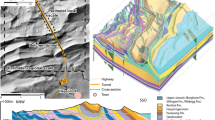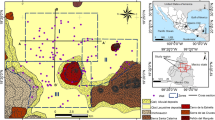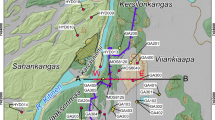Abstract
A geostatistical methodology is developed with the aim of simulating three-dimensional grids of transmissivity. The case study is a highly heterogeneous massif rock body, mainly composed of granites and schists with distinct weathering and fracture conditions, that surrounds and is part of a former uranium mine in central Portugal. Contrasting hydraulic behaviour is given by fractured rock and a pervasively weathered rock matrix composed mainly by clay minerals. Lithology, weathering, and fracture were the geological attributes selected for simulation. Data and information were analysed in detail for their respective integration into a sequential geostatistical modelling approach. The simulation process was conditioned to local data histograms. Simulation images of transmissivity show high degrees of heterogeneity both laterally and vertically. Potential areas for high-flow propagation are restricted in number and interconnectivity is not particularly evident. Small channels, the main structures responsible for groundwater flow propagation, can be identified within the rock body.
Résumé
Une méthode géostatistique est développée afin de simuler des grilles de transmissivité tridimensionnelles. Le massif étudié est constitué de formations géologiques fortement hétérogènes, il est principalement composé de granites et schistes soumis à des conditions d’altération et de fracturation diverses, qui entourent et constituent partiellement une ancienne mine d’uranium dans le centre du Portugal. Les roches fracturées et une matrice rocheuse intensément altérée, majoritairement composée de minéraux argileux, confèrent un comportement hydraulique contrasté. Les attributs géologiques retenus pour la simulation étaient la lithologie, l’altération et la fracturation. Les données et les informations ont été analysées en détail en vue de leur intégration respective dans une approche par modélisation géostatistique séquentielle. Le traitement par simulation a été conditionné à des histogrammes de données locales. La visualisation des simulations de transmissivité montre de fortes hétérogénéités, autant latérales que verticales. Les secteurs potentiels de propagation de flux élevés sont peu nombreux et leur interconnexion n’est. pas spécialement évidente. De petits conduits, constituant les principales structures propageant les flux d’eau souterraine, peuvent être identifiés dans le massif.
Resumen
Se desarrolla una metodologa geoestadstica con el objetivo de simular cuadrículas tridimensionales de transmisividad. El estudio de caso es un macizo rocoso altamente heterogéneo, compuesto principalmente por granitos y esquistos con distintas condiciones de meteorización y fractura, que rodea y forma parte de una antigua mina de uranio en el centro de Portugal. El comportamiento hidráulico contrastante está dado por la roca fracturada y una matriz de roca meteorizada en forma generalizada compuesta principalmente por minerales arcillosos. Litología, meteorización y fractura fueron los atributos geológicos seleccionados para la simulación. Los datos y la información se analizaron en detalle para su integración respectiva en un enfoque de modelización geoestadística secuencial. El proceso de simulación se condicionó a histogramas de datos locales. Las imágenes de simulación de la transmisividad muestran altos grados de heterogeneidad tanto lateral como verticalmente. El número de áreas potenciales para la propagación de alto flujo está restringido y la interconectividad no es particularmente evidente. Los canales pequeños, las principales estructuras responsables de la propagación del flujo de agua subterránea, pueden ser identificados dentro de la masa rocosa.
摘要
开发了模拟导水系数的三维网络的地质统计学方法。案例研究区是主要由具有明显风化和裂隙特征的花岗岩和片岩组成的高度非均质山丘岩体,周边是葡萄牙中部的前铀矿,案例区也包括一部分前铀矿区。在裂隙和主要由粘土矿物组成的普遍风化基质中发现明显不同的水力特征。选择岩性,风化程度和裂隙作为模拟的地质属性。详细分析了各类数据和信息,并将它们集成到序贯地质统计建模方法中。模拟过程以局部数据直方图展示。导水系数的模拟图像在侧向和垂向上均显示出高度的非均质性。高流量传导的潜在区域个数得到辨识,并且互连性不是特别明显。小通道是影响地下水流传导的主要结构,可以在岩体内进行识别。
Resumo
Uma metodologia geostatística foi desenvolvida com o objetivo de simular malhas tridimensionais de transmissividade. O caso de estudo é o de um maciço rochoso extremamente heterogéneo, maioritariamente composto por granitos e xistos com distintos graus de alteração e fracturação, localizado na envolvente a uma antiga mina de urânio situada na Zona Centro de Portugal. Neste maciço é evidente a existência de comportamentos hidráulicos distintos e contrastantes devidos a matrizes rochosas fraturadas e matrizes pervasivamente alteradas compostas maioritariamente por minerais argilosos. A litologia, o grau de alteração e a fracturação foram os atributos geológicos selecionados para simulação. Os dados e a informação disponível foram analisados em detalhe para respetiva integração de modo adequado num processo de simulação geostatística sequencial. O processo de simulação foi condicionado aos histogramas locais dos dados. Os resultados da simulação mostram imagens simuladas de transmissividade bastante heterogéneas quer lateralmente, quer em profundidade. As potenciais áreas com fluxos de maior caudal são restritas e escassas e a sua interconectividade não é particularmente evidente. No maciço rochoso observam-se pequenos canais locais que constituem as principais estruturas responsáveis pela propagação de fluxos.



















Similar content being viewed by others
References
Adler PM, Thovert J-F (1999) Fractures and fracture networks.Theory and applications of transport in Porous Media book series, v 15, Kluwer Academic Pub., Dordrecht, pp 430. https://doi.org/10.1007/978-94-017-1599-7
Almeida JA (2010) Stochastic simulation methods for characterization of lithoclasses in carbonate reservoirs. Earth-Sci Rev 101(3–4):250–270
Almeida JA, Barbosa S (2008) 3D stochastic simulation of fracture networks conditioned both to field observations and a linear fracture density. Proceedings of the Eighth International Geostatistics Congress, vol I. Santiago, Chile, December 2008, 8 pp
Almeida A, Soares A, Reynaud R (1993) Modelling the shape in several marble types in a quarry. In: Elbrond J, Tang X (eds) Proc. of APCOM XXIV, vol 3, Montreal, November 1993, pp 452–459
Arpat GB, Caers J (2007) Conditional simulation with patterns. Math Geol 39(2):177–203. https://doi.org/10.1007/s11004-006-9075-3
Barbosa S (2013) Modeling of hydrogeological attributes of the surrounding massif to the old mining area of Quinta do Bispo. PhD Thesis, NOVA Lisbon University, Portugal, 168 pp
Benedetto MF, Berrone S, Pieraccini S, Scialò S (2014) The virtual element method for discrete fracture network simulations. Comput Methods Appl Mech Eng 280:135–156
Berrone S, Canuto C, Pieraccini S, Scialò S (2015) Uncertainty quantification in discrete fracture network models: stochastic fracture transmissivity. Comput Math Appl 70(4):603–623
Berrone S, Pieraccini S, Scialò S (2016) Towards effective flow simulations in realistic discrete fracture networks. J Comput Phys 310:181–201
Bogdanov II, Mourzenko VV, Thovert J-F, Adler PM (2003) Effective permeability of fractured porous media in steady state flow. Water Resour Res 39:1023. https://doi.org/10.1029/2001WR000756
Bourbiaux B, Cacas MC, Sarda S, Sabathier JC (1998) A rapid and efficient methodology to convert fractured reservoir images into a dual-porosity model. Rev Instit Français Pétrol 53(6):785–799
Bourbiaux B, Basquet R, Daniel JM, Hu LY, Jenni S, Lange G, Rasolofosaon P (2005) Fractured reservoirs modelling: a review of the challenges and some recent solutions. First Break 23(9):33–40. https://doi.org/10.3997/1365-2397.2005018
Carlotto T, da Silva RV, Grzybowski JMV (2018) A GPGPU-accelerated implementation of groundwater flow model in unconfined aquifers for heterogeneous and anisotropic media. Environ Model Softw 101:64–72. https://doi.org/10.1016/j.envsoft.2017.12.004
Carvalho J, Ramalho EC, Barbosa S (2005) Using geophysical methods to identify alteration zones in an abandoned mining site. J Balkan Soc 8(Suppl 1):459–463
Castilla-Rho JC, Mariethoz G, Kelly BFJ, Andersen MS (2014) Stochastic reconstruction of paleovalley bedrock morphology from sparse datasets. Environ Model Softw 53:35–52
Caumon G, Collon-Drouaillet P, Le Carlier de Veslud C, Viseur S, Sausse J (2009) Surface-based 3D modeling of geological structures. Math Geosci 41:927–945
Chambel A (2006) (ed) Proceedings of the 2nd Workshop of the IAH Iberian Regional Working Group on Hard Rock Hydrogeology, Évora, Portugal. Commission on Hard Rock Hydrogeology, Iberian Regional Working Group, IHP Portugal, Lisbon, 247 pp
Chesnaux R, Allen DM, Jenni S (2009) Regional fracture network permeability using outcrop scale measurements. Eng Geol J 108:259–271
Chilès JP, Guérin F, Billaux D (1992) 3D stochastic simulation of fracture network and flow at Stripa conditioned on observed fractures and calibrated on measured flow rates. In: Tillerson JR, Wawersik WR (eds) Rock mechanics, Balkema, Rotterdam, The Netherlands, pp 533–542
Comunian A, Renard P, Straubhaar J, Bayer P (2011) Three-dimensional high resolution fluvio-glacial aquifer analog, part 2: geostatistical modeling. J Hydrol 405:10–23. https://doi.org/10.1016/j.jhydrol.2011.03.037
Delorme M, Mota RO, Khvoenkova N, Fourno A, Nœtinger B (2014) A methodology to characterize fractured reservoirs constrained by statistical geological analysis and production: a real field case study. Geol Soc Lond Spec Publ 374(1):273–288. https://doi.org/10.1144/SP374.14
Dimitrakopoulos R (1998) Conditional simulation algorithms for modelling orebody uncertainty in open pit optimisation. Int J Surf Min Reclam Environ 12(4):173–179. https://doi.org/10.1080/09208118908944041
Dreuzy J R, Méheust Y, Pichot G (2012) Influence of fracture scale heterogeneity on the flow properties of three-dimensional discrete fracture networks (DFN). J Geophys Res 117(B11). https://doi.org/10.1029/2012JB009461
Durão RM, Pereira MJ, Branquinho C, Soares A (2010) Assessing spatial uncertainty of the Portuguese fire risk through direct sequential simulation. Ecol Model 221(1):27–33
Eaton T (2006) On the importance of geological heterogeneity for flow simulation. Sediment Geol 184:187–201. https://doi.org/10.1016/j.sedgeo.2005.11.002
Fialho A, Chambel A, Almeida C (1998) Caracterização hidráulica de aquíferos fracturados por modelos de porosidade dupla no concelho de Évora [Hydraulic characterization of fractured aquifers by double porosity models in the municipality of Évora]. Proc. of the 4th Water Congress, Lisbon, March 1998, 12 pp
Fourno A, Grenier C, Delay F, Mouche E, Benabderrahmane H (2004) Smeared fractures: a promising approach to model transfers in fractured media. Dev Water Sci 55:1003–1014
Fourno A, Grenier C, Benabderrahmane A, Delay F (2013) A continuum voxel approach to model flow in 3D fault networks: a new way to obtain up-scaled hydraulic conductivity tensors of grid cells. J Hydrol 493:68–80
Froidevaux R (1993) Probability field simulation. In: Soares A (ed) Geostatistics Troia’92, vol 1. Kluwer, Dordrecht, The Netherlands, pp 73–84
Grossman N (1988) Estudo das descontinuidades e sua influência no comportamento das rochas e maciços rochosos: as descontinuidades nos maciços rochosos—características geométricas e influência na deformabilidade dos maciços [Study of the discontinuities and their influence on the behaviour of rocks and rock massifs: the discontinuities in the rocky massifs—geometric characteristics and influence on mass deformability]. LNEC, Lisbon, 118 pp
Handy MR (1989) Deformation regimes and the rheological evolution of fault zones in the lithosphere: the effects of pressure, temperature, grain size and time. Tectonophysics 163:119–152
Jenni S, Hu LY, Basquet R, de Marsily G, Bourbiaux B (2007) History matching of a stochastic model of field-scale fractures: methodology and case study. Oil Gas Sci Technol 62(2):265–276
Journel AG (1994) Modeling uncertainty: some conceptual thoughts. In: Dimitrakopoulos R (ed) Geostatistics for the next century. Kluwer, Dordrecht, The Netherlands
Kanevski M, Parkin R, Pozdnukhov A, Timonin V, Maignan M, Demyanov V, Canu S (2004) Environmental data mining and modeling based on machine learning algorithms and geostatistics. Environ Model Softw 19:845–855
Kaufmann O, Martin T (2008) 3D geological modelling from boreholes, cross-sections and geological maps, application over former natural gas storages in coal mines. Comput Geosci 34:278–290. https://doi.org/10.1016/j.cageo.2007.09.005
Landereau P, Noetinger B, Quintard M (2001) Quasi-steady two-equation models for diffusive transport in fractured porous media: large-scale properties for densely fractured systems. Adv Water Resour 24(8):863–876
Lemonnier P, Bourbiaux B (2010a) Simulation of naturally fractured reservoirs: state of the art, part 1—physical mechanisms and simulator formulation. Oil Gas Sci Technol 65(2):239–262. https://doi.org/10.2516/ogst/2009066
Lemonnier P, Bourbiaux B (2010b) Simulation of naturally fractured reservoirs: state of the art, part 2—matrix-fracture transfers and typical features of numerical studies. Oil Gas Sci Technol 65(2):263–286
Lin L, Jia H, Xu Y (2007) Fracture network characteristics of a deep borehole in the Table Mountain group (TMG), South Africa. Hydrogeol J 15(7):1419–1432. https://doi.org/10.1007/s10040-007-0184-y
Lukes J (2005) Methods of well logging used for borehole correlation in the granite stock, Podlesí granite, Bohemian massif. Bull Geosci 80(2):155–161
Marsily G, Delay F, Gonçalvès J, Renard P, Teles V, Violette S (2005) Dealing with spatial heterogeneity. Hydrogeol J 13:161–183. https://doi.org/10.1007/s10040-004-0432-3
Matheron G, Beucher H, de Fouquet C, Galli A et Ravenne C (1988) Simulation conditionnelle à trois faciès dans une falaise de la formation du Brent. Sciences de la Terre, no 28, Etudes Geostatistiques V, 213–249
Matias F (2010) Modelação 3D de um Subsector das Mineralizações Auríferas de Casas Novas, Montemor-o-Novo [3D modeling of a subsector of auricular mineralizations in Casas Novas, Montemor-o-Novo]. MSc Thesis, FCT-UNL, Lisbon, Portugal, 121 pp
Michael HA, Li H, Boucher A, Sun T, Caers J, Gorelick SM (2010) Combining geologic-process models and geostatistics for conditional simulation of 3-D subsurface heterogeneity. Water Resour Res 46(5):W05527. https://doi.org/10.1029/2009WR008414
Moench AF (1984) Double-porosity models for a fissured groundwater reservoir with fracture skin. Water Resour Res 7:831–846
Molson J, Aubertin M, Bussière B (2012) Reactive transport modelling of acid mine drainage within discretely fractured porous media: plume evolution from a surface source zone. Environ Model Softw 38:259–270
Ngo TD, Fourno A, Noetinger B (2017) Modeling of transport processes through large-scale discrete fracture networks using conforming meshes and open-source software. J Hydrol 554:66–79
Noetinger B, Jarrige N (2012) A quasi steady state method for solving transient Darcy flow in complex 3D fractured networks. J Comput Phys 231(1):23–38
Noetinger B, Estebenet T, Landereau P (2001) A direct determination of the transient exchange term of fractured media using a continuous time random walk method. Transp Porous Media 44(3):539–557
Noetinger B, Roubinet D, Russian, Le Borgne T, Delay F, Dentz M, Dreuz J-R, Gouze P (2016) Random walk methods for modeling hydrodynamic transport in porous and fractured media from pore to reservoir scale. Transp Porous Media 115(2):345–385
Nunes R, Almeida JA (2010) Parallelization of sequential Gaussian, indicator and direct simulation algorithms. Comput Geosci 36:1042–1052
Pereira MR, Almeida C (1997) Interpretação de ensaios de caudal de aquíferos fracturados em Trás-os-Montes Oriental (Portugal) por modelos de porosidade dupla e por métodos clássicos (Interpretation of flow tests of fractured aquifers in Trás-os-Montes Oriental (Portugal) by double porosity models and by classical methods). In: Villaroya F, Yélamos JG (eds) Hydrogeology of hard rocks some experiences from Iberian Peninsula and Bohemian Massif, Madrid, pp 15–29
Pereira AJSC, Neves LJPF, Dias JMM, Barbosa SVT (2005) Environmental hazards at the former uranium mines Urgeiriça, Cunha Baixa and Quinta do Bispo. Environmental contamination from uranium production facilities and remediation measures. IAEA publication, Lisboa, 181–191
Pereira AJSC, Neves LJPF, Dias JMM (2007) Estimating geochemical impacts of uranium mining exploitation: The evaluation of the natural background in the Beiras metalogenetic province (Central Portugal). Geochimica et Cosmochimica Acta 71, 15:A777–A777
Pichot G, Erhel J, De Dreuzy JR (2010) A mixed hybrid mortar method for solving flow in discrete fracture networks. Appl Anal 89(10):1629–1643
Pichot G, Erhel J, de Dreuzy JR (2012) A generalized mixed hybrid mortar method for solving flow in stochastic discrete fracture networks. SIAM J Sci Comput 34(1):B86–B105
Quental P, Almeida JA, Simões M (2012) Construction of high-resolution stochastic geological models and optimal upscaling to a simplified layer-type hydrogeological model. Adv Water Resour 39:18–32
Röhrich T (2005) AquiferTest v. 4.0. user’s manual: advanced pumping test and slug test analysis software. AQTESOLV, Reston, VA
Roxo S (2011) Integração de informação secundária na modelação geoestatistica da qualidade de solos em locais potencialmente contaminados. Aplicação à área subjacente de uma antiga refinaria, Tese de mestrado (Integration of secondary information in the geostatistical modeling of soil quality in potentially contaminated sites. Application to the underlying area of an old refinery, Master thesis). NOVA University of Lisbon, Faculdade de Ciências e Tecnologia da Universidade Nova de Lisboa, pp 64
Roxo S, Almeida JA, Matias F, Barbosa S (2016) The use of sensory perception indicators for improving the characterization and modelling of total petroleum hydrocarbon (TPH) in soils. Environ Monit Assess 188:129. https://doi.org/10.1007/s10661-016-5135-4
Ruben N, Almeida JA (2010) Parellelization of sequential Gaussian, indicator and direct simulation algorithms. Comput Geosci 36(8):1042–1052
Sausse J, Genter A (2005) Types of permeable fractures in granite: petrophysical properties of crystalline rocks. Geol Soc Lond Spec Publ 240:1–14
Shafer JM (2014) Conditional simulation. In: Wiley StatsRef: statistics reference online. https://doi.org/10.1002/9781118445112.stat07175
Soares A (1992) Geostatistical estimation of multi-phase structures. Math Geol 24(2):149–160
Soares A (1998) Sequential Indicator simulation with correction for local probabilities. Math Geol 30(6):761–765
Soares A (2001) Direct sequential simulation and cosimulation. Math Geol 33(8):911–926
Soares A (2006) Geoestatística para as Ciências da Terra e do Ambiente [Geostatistics for earth and environment sciences]. IST, Lisbon, 214 pp
Soares A, Brusco A (1997) Simulation of naturally fracturated reservoirs. In: Baafi EY, Schofield NA (eds) Geostatistics Wollongong’96, vol 1. Kluwer, Dordrecht, The Netherlands, pp 433–442
Srivastava M (1992) Reservoir characterization with probability field simulation, SPE Paper no. 24753, SPE, Richardson, TX
Srivastava M (2005) Probabilistic modeling of ore lens geometry: an alternative to deterministic wireframes. Math Geol 37(5):513–544
Telles IA (2006) Desenvolvimento de um sistema integrado Para modelagem de fluxo e transporte em meios porosos e fracturados [Development of an integrated system for flow and transport modeling in porous and fractured media]. PhD Thesis, Pontifícia Universidade Católica do Rio de Janeiro, Rio de Janeiro, 164 pp
Verscheure M, Fourno A, Chilès JP (2012) Joint inversion of fracture model properties for CO2 storage monitoring or oil recovery history matching. Oil Gas Sci Technol 67(2):221–235
Wu Q, Xu H, Zou X (2005) An effective method for 3D geological modeling with multi-source data integration. Comput Geosci 31:35–43. https://doi.org/10.1016/j.cageo.2004.09.005
Acknowledgments
The authors thank Midland Valley for the possibility of using software MOVE 2012.1 in accordance with the agreement conditions established with FCT Universidade NOVA.
Funding
This work is a contribution to Project UID/GEO/04035/2013 funded by FCT-Fundação para a Ciência e a Tecnologia, in Portugal.
Author information
Authors and Affiliations
Corresponding author
Ethics declarations
Conflict of interest
Declarations of interest: none.
Rights and permissions
About this article
Cite this article
Barbosa, S., Almeida, J. & Chambel, A. A geostatistical methodology to simulate the transmissivity in a highly heterogeneous rock body based on borehole data and pumping tests. Hydrogeol J 27, 1969–1998 (2019). https://doi.org/10.1007/s10040-019-01980-7
Received:
Accepted:
Published:
Issue Date:
DOI: https://doi.org/10.1007/s10040-019-01980-7




